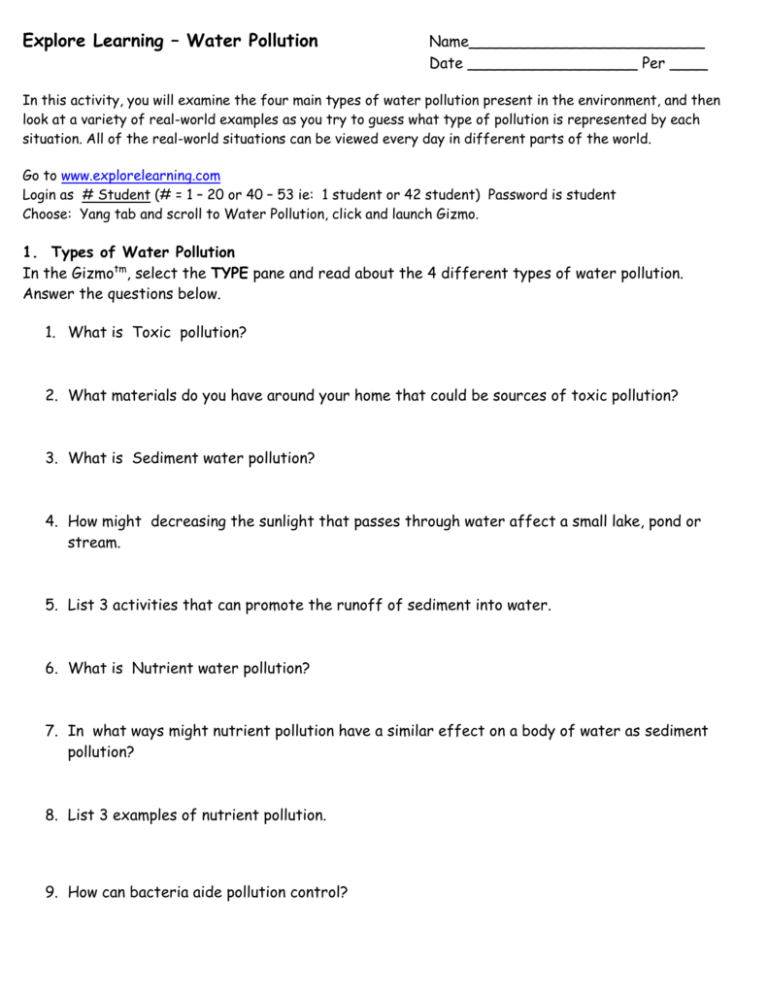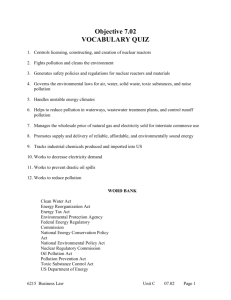water pollution gizmo
advertisement

Explore Learning – Water Pollution Name_________________________ Date __________________ Per ____ In this activity, you will examine the four main types of water pollution present in the environment, and then look at a variety of real-world examples as you try to guess what type of pollution is represented by each situation. All of the real-world situations can be viewed every day in different parts of the world. Go to www.explorelearning.com Login as # Student (# = 1 – 20 or 40 – 53 ie: 1 student or 42 student) Password is student Choose: Yang tab and scroll to Water Pollution, click and launch Gizmo. 1. Types of Water Pollution In the Gizmotm, select the TYPE pane and read about the 4 different types of water pollution. Answer the questions below. 1. What is Toxic pollution? 2. What materials do you have around your home that could be sources of toxic pollution? 3. What is Sediment water pollution? 4. How might decreasing the sunlight that passes through water affect a small lake, pond or stream. 5. List 3 activities that can promote the runoff of sediment into water. 6. What is Nutrient water pollution? 7. In what ways might nutrient pollution have a similar effect on a body of water as sediment pollution? 8. List 3 examples of nutrient pollution. 9. How can bacteria aide pollution control? 10. What can bacteria in soil, water or air cause? 11. What are some common sources of bacterial pollution? 2. Sources of Water Pollution Select the EXAMPLE tab, use the right or left arrows to display the 12 real world examples. In this activity, you will analyze situations that can lead to one or more types of water pollution. Read each example carefully. Then select the types of water pollution that could result from this situation. On your answer sheet circle the type of water pollution that could result from each situation. Click Check answer. Be sure to correct your answer sheet. As you work through each example answer the question that corresponds with each situation. Example 1: Pollution type: Toxic Sediment Nutrient Bacterial What could the farmer do differently to reduce the likelihood of these types of pollution? Example 2: Pollution type: Toxic Sediment Nutrient Bacterial Think about your family's driving habits. Identify two ways that you could reduce the total mileage that your family drives each week. Example 3: Pollution type: Toxic Sediment Nutrient Bacterial Food that is labeled as "organic" is becoming more popular. How is organic food better for environment? Example 4: Pollution type: Toxic Sediment Nutrient Bacterial The developers of this property made a good decision when they built a silt fence (minimizes erosion) at the low side of the property. How might they have further reduced the likelihood of sedimentary pollution? Example 5: Pollution type: Toxic Sediment Nutrient Bacterial Can you think of a better way to dispose of used oil and antifreeze? What procedures should be used? Example 6: Pollution type: Toxic Sediment Nutrient What might be an alternative solution to removing the trees and shrubs? Bacterial Example 7: Pollution type: Toxic Sediment Nutrient Bacterial Why might these homeowners just want to keep their extra paint, rather than dispose of it? Example 8: Pollution type: Toxic Sediment Nutrient Bacterial Consider your family's water consumption habits. In what ways could you better conserve water in your home? Example 9: Pollution type: Toxic Sediment Nutrient Bacterial Think about the packaging that consumer products, including groceries, come in. Identify the three most extreme cases of excessive packaging. How would you suggest reducing the amount of packaging used? Example 10: Pollution type: Toxic Sediment Nutrient What might the developer do differently to avoid the damage to the stream? Bacterial Example 11: Pollution type: Toxic Sediment Nutrient Bacterial How can the homeowners still fertilize their plants without worrying about harming the environment? Example 12: Pollution type: Toxic Sediment What damage can a poorly maintained septic tank cause? Nutrient Bacterial 3. Assessment Questions When you finish answer the assessment questions and check your answers and print the results.





